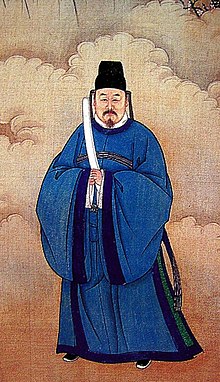Jinshi

| Jinshi | |||||||||||||||||||
|---|---|---|---|---|---|---|---|---|---|---|---|---|---|---|---|---|---|---|---|
| Chinese name | |||||||||||||||||||
| Traditional Chinese | 進士 | ||||||||||||||||||
| Simplified Chinese | 进士 | ||||||||||||||||||
| Literal meaning | "entered scholar" | ||||||||||||||||||
| |||||||||||||||||||
| Vietnamese name | |||||||||||||||||||
| Vietnamese alphabet | Tiến sĩ | ||||||||||||||||||
| Chữ Hán | 進士 | ||||||||||||||||||
Jinshi (Chinese: 進士; pinyin: jìnshì) was the highest and final degree in the imperial examination in Imperial China.[1][2] The examination was usually taken in the imperial capital in the palace, and was also called the Metropolitan Exam. Recipients are sometimes referred to in English-language sources as Imperial Scholars.[3]
The jinshi degree was first created after the institutionalization of the civil service exam. Initially it had been "for six categories" but was later consolidated into a single degree. This system first appeared during the Han dynasty (206 BC – AD 220).[2] Throughout the Tang dynasty, every year around one to two percent of test takers would obtain a jinshi title out of a total of one to two thousand test takers.[4]
The numbers of Jinshi degrees given out were increased in the Song dynasty, and the examinations were given every three years. Most senior officials of the Song dynasty were jinshi holders.[5]
The Ming dynasty resumed the civil-service exam after its occurrence became more irregular in the Yuan dynasty. After the reign of the Emperor Yingzong of Ming, it became the rule that only jinshi holders could enter the Hanlin Academy. On average around 89 jinshi per year were conferred.[6]
During the Qing dynasty around 102 jinshi degrees were given a year.
The highest scoring jinshi in the country was known as the zhuangyuan, a term that survives today as a high scoring gaokao test taker or just someone who is very good at a skill.
Subtypes of jinshi recipients
- Jinshi Jidi (進士及第, lit. "distinguished jinshi"), graduates ranked first class in the court exam, usually only the top three individuals were qualified for this title.
- Zhuangyuan (狀元, lit. "top thesis author"), the jinshi who ranked first overall nationwide.
- Bangyan (榜眼, lit. "eyes positioned alongside"), the jinshi who ranked second overall just below zhuangyuan.
- Tanhua (探花, lit. "flower snatcher"), the jinshi ranked third overall.
- Jinshi Chushen (進士出身, lit. "jinshi background"), the graduates who ranked second class in court exam, ranking immediately after the tanhua.
- Tong Jinshi Chushen (同進士出身, lit. "along with jinshi background"), graduates ranked third class in the court exam.

See also
Notes
References
- ^ The Chinese Imperial Examination System: An Annotated Bibliography.
- ^ a b Hagras, Hamada (2019-12-20). "The Ming Court as Patron of the Chinese Islamic Architecture: The Case Study of the Daxuexi Mosque in Xi'an". SHEDET (6): 134–158. doi:10.36816/shedet.006.08.
- ^ "Scholar-Officials of China | Essay | The Metropolitan Museum of Art | Heilbrunn Timeline of Art History". The Met’s Heilbrunn Timeline of Art History. Retrieved 2023-10-06.
- ^ Fu, Zhengyuan. Autocratic Tradition and Chinese Politics. p. 98.
- ^ History of Song
- ^ Ho 1962











